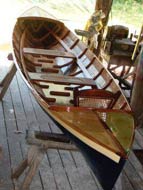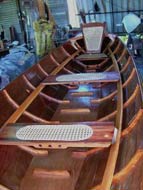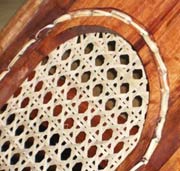Thoughts on Thwarts
|

|
A friend was taking a look at the 17 foot kitset rowing boat I was building for the 2006 Classic and Wooden Boat Festival (Darling Harbour March 11-13th) and whilst admiring the boat and especially the cane seats posed the question, ”Looks all right but does it all work”
"Hell yeah!" I replied.
 |
”Looks all right but does it all work”
"Hell yeah!" I replied.
(click images for larger views) |
|
Later on, rowing up the river and of course in a contemplative frame of mind as one often is whilst rowing I came up with a few answers.
Around 1830 Michael Thonet an Austrian furniture maker started designing and building furniture using boat-building methods. Light, strong and elegant and durable, using bent Beechwood laminated with glue, his village workshop evolved into an industry of global proportions. His chair #14 became arguably the worlds first mass-produced item, made of 6 pieces of laminated wood and a woven cane seat; it is a paragon of elegant design. Did it work? Well, by 1920 it is estimated 30 million #14 chairs had been produced. The trick was to use an industrial method to produce the bentwood components and have them carefully assembled by hand. A bit like kitset boats really.
| L.F Herreshoffs lines for the 17 footer are another paragon of design, I reckon. |

|
|
L.F Herreshoffs lines for the 17 footer are another paragon of design, I reckon, 30 million, hmm. The cane seat is a proven feature of traditional small boats. Anyone who has spent some quality recreational time sitting on a thwart of solar heated aluminium, or in a puddle of water would understand why. Wood is much better, woven cane is bliss. To quote William Wordsworth:
“How calm! How still! The only sound the dripping of the oar suspended“.
Not with a wet bum Bill!
 |
Notice the cane is woven through holes in the thwart, a much stronger job and to my eye, the slightly not quite geometrically perfect effect is a more pleasing.
|
|
Looking through the books on the cheapo table in the mall I spotted a lovely coffee table hardback on traditional canoe building. The venerable builder was caning a thwart with sheet woven cane. So heres a way to do it yourself. The cane sheet is held in place by a round cane tacked into a routed groove I prefer to get the job done by hand weaving - time consuming and baffling work. Luckily I know a charming couple who have the skills do this work at a reasonable price though a little more than the 2 to 12 florins a day that M.Thoret paid his staff. Look at the photos: notice the cane is woven through holes in the thwart, a much stronger job and to my eye the slightly not quite geometrically perfect effect, is a more pleasing. The shape of the little hexagons is the result of the shape of the frame; the sheet stuff looks as if it was woven over a symmetrical square or round frame.
| One spends a lot of time looking at the aft cane seat in a rowing boat. |

|
|
Splitting hairs, (or cane) perhaps but one spends a lot of time looking at the aft cane seat in a rowing boat, yes its there to please the rower as well as spoiling the passenger, and you have little aesthetically relevant thoughts like these, resting on the ”dripping oar suspended’’ especially if you have a dry bum.
Mike Smith - www.Corakiboatshed.com.au
|